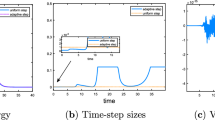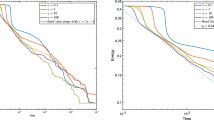Abstract
The two-step backward differential formula (BDF2) with unequal time-steps is applied to construct an energy stable convex-splitting scheme for the Cahn–Hilliard model. We focus on the numerical influences of time-step variations by using the recent theoretical framework with the discrete orthogonal convolution kernels. Some novel discrete convolution embedding inequalities with respect to the orthogonal convolution kernels are developed such that a concise \(L^2\) norm error estimate is established at the first time under an updated step-ratio restriction \(0 <r_k:=\tau _k/\tau _{k-1}\le r_{\mathrm {user}}\), where \(r_{\mathrm {user}}\) can be chosen by the user such that \(r_{\mathrm {user}}<4.864\). The stabilized convex-splitting BDF2 scheme is shown to be mesh-robustly convergent in the sense that the convergence constant (prefactor) in the error estimate is independent of the adjoint time-step ratios. The suggested method is proved to preserve a modified energy dissipation law at the discrete levels if \(0<r_k\le r_{\mathrm {user}}\), such that it is mesh-robustly stable in an energy norm. On the basis of ample tests on random time meshes, a useful adaptive time-stepping strategy is applied to efficiently capture the multi-scale behaviors and to accelerate the long-time simulation approaching the steady state.





Similar content being viewed by others
Data Availability
Enquiries about data availability should be directed to the authors.
References
Becker, J.: A second order backward difference method with variable steps for a parabolic problem. BIT 38(4), 644–662 (1998)
Bertozzi, A., Esedoglu, S., Gillette, A.: Inpainting of binary images using the Cahn–Hilliard equation. IEEE Trans. Image Process. 16, 285–291 (2007)
Cheng, K., Feng, W., Wang, C., Wise, S.: An energy stable fourth order finite difference scheme for the Cahn–Hilliard equation. J. Comput. Appl. Math. 362, 574–595 (2019)
Cahn, J., Hilliard, J.: Free energy of a nonuniform system I. Interfacial free energy. J. Chem. Phys. 28, 258–267 (1958)
Cristini, V., Li, X., Lowengrub, J., Wise, S.: Nonlinear simulations of solid tumor growth using a mixture model: invasion and branching. J. Math. Biol. 58, 723–763 (2009)
Cheng, K., Wang, C., Wise, S.: An energy stable BDF2 Fourier pseudo-spectral numerical scheme for the square phase field crystal equation. Comm. Comput. Phys. 26(5), 1335–1364 (2019)
Chen, W., Wang, C., Wang, X., Wise, S.: A linear iteration algorithm for a second-order energy stable scheme for a thin film model without slope selection. J. Sci. Comput. 59, 574–601 (2014)
Cheng, K., Wang, C., Wise, S., Yue, X.: A second-order, weakly energy-stable pseudo-spectral scheme for the Cahn–Hilliard equation and its solution by the homogeneous linear iteration method. J. Sci. Comput. 69, 1083–1114 (2016)
Chen, W., Wang, X., Yan, Y., Zhang, Z.: A second order BDF numerical scheme with variable steps for the Cahn–Hilliard equation. SIAM J. Numer. Anal. 57(1), 495–525 (2019)
Emmrich, E.: Stability and error of the variable two-step BDF for semilinear parabolic problems. J. Appl. Math. Comput. 19, 33–55 (2005)
Grigorieff, R.D.: Stability of multistep-methods on variable grids. Numer. Math. 42, 359–377 (1983)
Gomez, H., Hughes, T.: Provably unconditionally stable, second-order time-accurate, mixed variational methods for phase-field models. J. Comput. Phys. 230, 5310–5327 (2011)
Guo, J., Wang, C., Wise, S., Yue, X.: An \(H^2\) convergence of a second-order convex-spliting, finite difference scheme for the three-dimensional Cahn–Hilliard equation. Commun. Math. Sci. 14(2), 486–515 (2016)
He, Y., Liu, Y., Tang, T.: On large time-stepping methods for the Cahn–Hilliard equation. Appl. Numer. Math. 57, 616–628 (2007)
Hairer, E., Nørsett, S.P., Wanner, G.: Solving Ordinary Differential Equations I: Nonstiff Problems, Volume 8 of Springer Series in Computational Mathematics, 2nd edn. Springer, Berlin (1992)
Hosea, M.E., Shampine, L.F.: Analysis and implementation of TR-BDF2. Appl. Numer. Math. 20, 21–37 (1996)
Huang, J., Yang, C., Wei, Y.: Parallel energy-stable solver for a coupled Allen–Cahn and Cahn–Hilliard system. SIAM J. Sci. Comput. 42(5), C294–C312 (2020)
Liao, H.-L., Ji, B., Zhang, L.: An adaptive BDF2 implicit time-stepping method for the phase field crystal model. IMA J. Numer. Anal. 42(1), 649–679 (2022)
Liao, H.-L., Song, X., Tang, T., Zhou, T.: Analysis of the second order BDF scheme with variable steps for the molecular beam epitaxial model without slope selection. Sci. China Math. 64(5), 887–902 (2021)
Liao, H.-L., Tang, T., Zhou, T.: On energy stable, maximum-principle preserving, second order BDF scheme with variable steps for the Allen–Cahn equation. SIAM J. Numer. Anal. 58(4), 2294–2314 (2020)
Liao, H.-L., Tang, T., Zhou, T.: Positive definiteness of real quadratic forms resulting from variable-step approximations of convolution operators arXiv:2011.13383v1 (2020)
Liao, H.-L., Zhang, Z.: Analysis of adaptive BDF2 scheme for diffusion equations. Math. Comput. 90, 1207–1226 (2020)
Nishikawa, H.: On large start-up error of BDF2. J. Comput. Phys. 392, 456–461 (2019)
Qiao, Z., Zhang, Z., Tang, T.: An adaptive time-stepping strategy for the molecular beam epitaxy models. SIAM J. Sci. Comput. 33(3), 1395–1414 (2011)
Shen, J., Tang, T., Wang, L.: Spectral Methods: Algorithms, Analysis and Applications. Springer, Berlin (2011)
Shen, J., Wang, C., Wang, X., Wise, S.M.: Second-order convex-splitting schemes for gradient flows with Ehrlich–Schwoebel type energy: application to thin film epitaxy. SIAM J. Numer. Anal. 50(1), 105–125 (2012)
Tumolo, G., Bonaventura, L.: A semi-implicit, semi-Lagrangian, DG framework for adaptive numerical weather prediction. Q. J. R. Meteorol. Soc. (2015). https://doi.org/10.1002/qj.2544
Wang, W., Chen, Y., Fang, H.: On the variable two-step IMEX BDF method for parabolic integro-differential equations with nonsmooth initial data arising in finance. SIAM J. Numer. Anal. 57(3), 1289–1317 (2019)
Wang, L., Yu, H.: On efficient second order stabilized semi-implicit schemes for the Cahn–Hilliard phase-field equation. J. Sci. Comput. 77, 1185–1209 (2018)
Xu, C., Tang, T.: Stability analysis of large time-stepping methods for epitaxial growth models. SIAM J. Numer. Anal. 44(4), 1759–1779 (2006)
Zhang, Z., Qiao, Z.: An adaptive time-stepping strategy for the Cahn–Hilliard equation. Commun. Comput. Phys. 11(4), 1261–1278 (2012)
Funding
The authors have not disclosed any funding.
Author information
Authors and Affiliations
Corresponding author
Ethics declarations
Conflict of interests
The authors have not disclosed any competing interests.
Additional information
Publisher's Note
Springer Nature remains neutral with regard to jurisdictional claims in published maps and institutional affiliations.
Hong-lin Liao is supported by a Grant 12071216 from National Natural Science Foundation of China. Zhimin Zhang is supported in part by the NSFC Grant 11871092 and NSAF Grant U1930402.
Rights and permissions
About this article
Cite this article
Liao, Hl., Ji, B., Wang, L. et al. Mesh-Robustness of an Energy Stable BDF2 Scheme with Variable Steps for the Cahn–Hilliard Model. J Sci Comput 92, 52 (2022). https://doi.org/10.1007/s10915-022-01861-4
Received:
Revised:
Accepted:
Published:
DOI: https://doi.org/10.1007/s10915-022-01861-4
Keywords
- Cahn–Hilliard model
- Adaptive BDF2 method
- Discrete energy dissipation law
- Orthogonal convolution kernels
- Discrete convolution embedding inequality
- Error estimate




